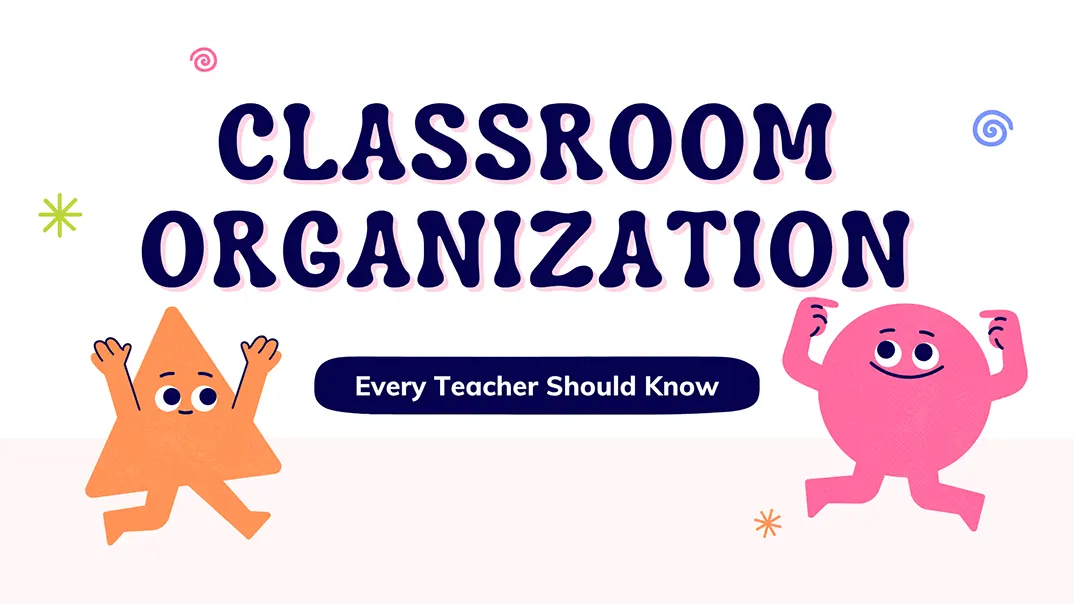Do you ever feel overwhelmed by the chaos of your classroom? Are supplies scattered, papers piling up, and your students struggling to stay focused? If so, you’re not alone. Many teachers struggle with maintaining effective classroom organization. Without a solid system, valuable teaching time is wasted, stress levels rise, and student behavior suffers. But how do you create a structured environment without spending a fortune or sacrificing flexibility?
The answer lies in mastering the art of classroom organization—a set of strategies designed to help educators optimize their space, routines, and resources for maximum efficiency. Whether it’s through clever storage hacks, desk layouts, or labeling systems, classroom organization means more than just tidiness; it supports better learning outcomes, promotes positive behavior, and makes your day-to-day teaching more manageable.
In this guide, we’ll explore powerful yet practical classroom organization ideas that every teacher should know and implement. Keep reading to unlock practical, proven strategies that will help you master classroom organization.
What Is Classroom Organization?
Classroom organization refers to the intentional structuring of the physical, instructional, and procedural elements of a classroom to create an environment that supports effective teaching and learning. It involves the arrangement of furniture, storage of materials, management of student belongings, creation of functional zones, and establishment of clear routines and procedures.
In a well-organized classroom, you’ll notice more than just neat shelves or clean floors. You’ll see engaged students who know where to find supplies, follow predictable routines, and feel a sense of ownership and responsibility in their learning space. Teachers in organized classrooms tend to feel less stressed, more in control, and better equipped to focus on instruction instead of managing clutter or confusion.

Key components of classroom organization include:
- Layout and Space Planning: Arranging desks, learning centers, and movement paths for accessibility and engagement.
- Storage and Materials Management: Ensuring that supplies are easy to access, use, and return.
- Student Responsibility Systems: Assigning jobs, establishing routines, and teaching organization habits.
- Visual Management: Using displays, schedules, and labels to support instruction and student self-direction.
- Teacher Workflow: Keeping lesson plans, assessments, and teaching tools well managed and accessible.
How Does Classroom Organization Affect Learning?
The impact of classroom organization on student learning is profound, far-reaching, and often underestimated. An organized classroom isn’t just visually pleasing—it actively supports the cognitive, emotional, and behavioral aspects of how children absorb and retain information. When structure and systems are in place, students thrive in an environment that reduces stress, enhances focus, and promotes meaningful engagement.
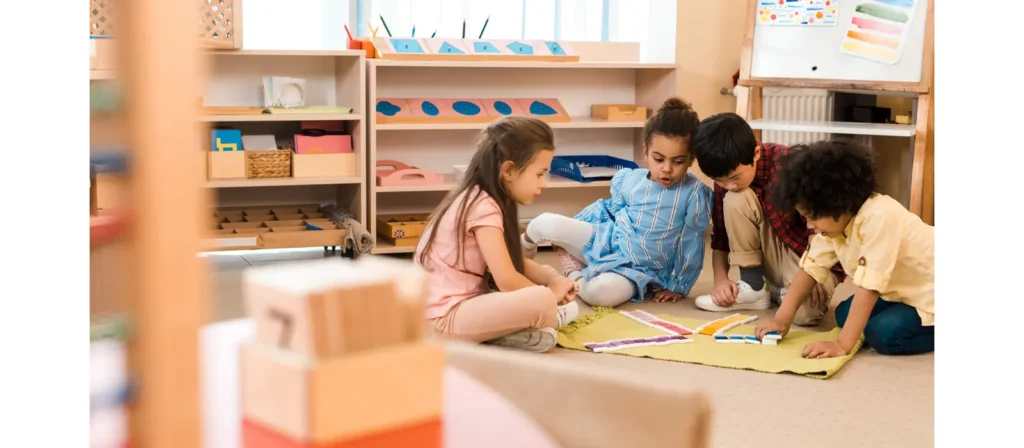
1. Improved Focus and Reduced Distractions
A clutter-free, thoughtfully arranged environment helps students concentrate on their work. When materials are neatly stored and visual noise is minimized, students are less likely to be distracted and more likely to stay on task. This is especially crucial for younger children or those with attention difficulties.
2. Increased Time on Task
Clear routines, accessible materials, and organized transitions mean less time wasted looking for supplies or explaining procedures. This allows for more minutes spent on meaningful instruction, small-group activities, and one-on-one support. Over time, these saved minutes add up to significant gains in learning time.
3. Stronger Student Independence and Responsibility
When classrooms are organized in a way that allows students to access and return educational materials on their own, they develop self-management skills. Systems like labeled bins, job charts, and visual schedules teach students to take responsibility for their environment, building executive function skills like planning, organizing, and following directions.
4. Better Behavior and Classroom Climate
A predictable, well-structured daycare environment gives students a sense of safety and clarity. They know what’s expected, where things go, and how the classroom functions. This reduces anxiety, minimizes behavior issues, and creates a calmer, more respectful learning space.
5. Support for Differentiated Learning
Organized materials and defined zones (e.g., reading nook, math center, sensory area) allow teachers to offer tailored experiences for diverse learners. Students can move smoothly between activities designed for different skill levels, learning styles, and interests, without confusion or downtime.
6. Enhanced Teacher Efficiency
When teachers can quickly find lesson plans, manipulatives, or assessment tools, they spend less time managing chaos and more time connecting with students. An organized space also makes it easier to prepare for lessons, reflect on progress, and adapt instruction as needed.
Principles of Classroom Organization
Effective classroom organization isn’t just about neat shelves and labeled bins—it’s rooted in core principles that ensure your classroom functions as a learning-centered, student-friendly space. These guiding principles help teachers create environments that support focus, independence, and academic success. Let’s explore the most essential classroom organization principles every educator should follow.
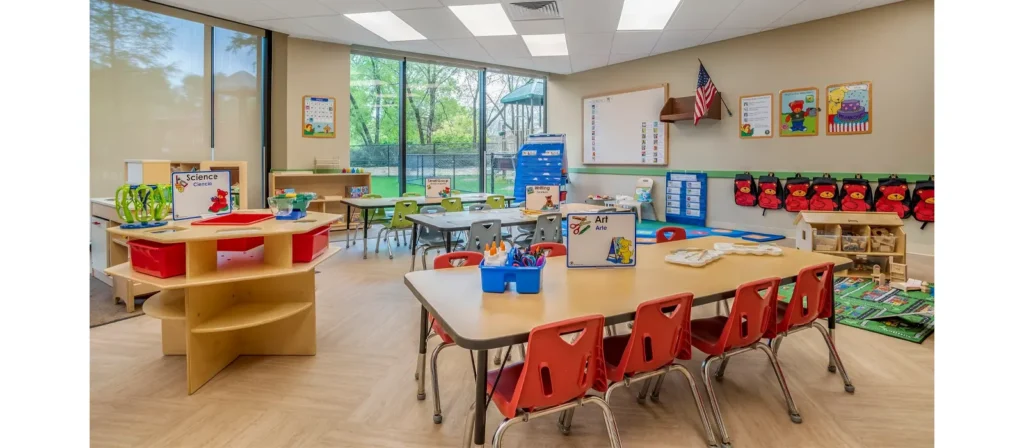
Functionality First
Every element in your classroom should serve a clear purpose. Whether it’s a reading corner, supply bin, or student desk, it needs to support learning outcomes or student development. Avoid cluttering the space with decorations or furniture that aren’t actively contributing to your teaching goals. A functional space reduces distractions and keeps both you and your students focused on what matters most—learning.
Accessibility and Independence
Materials and resources should be accessible to students without constant teacher assistance. This builds student independence and encourages responsibility. Store commonly used items at child-friendly heights and use visual labels (pictures + words) so students can identify and return items on their own. The more self-sufficient your students are, the smoother your routines will be.
Consistency in Systems and Routines
Consistency is the backbone of strong classroom organization. Establish clear routines for daily transitions, materials use, cleanup, and movement. When students know what to expect and where everything belongs, they can function with less guidance and more confidence. Consistent systems also reduce behavior issues and save instructional time.
Flexibility to Adapt
No two groups of students are the same. An organized classroom must also be a flexible one. Be ready to adapt your organization’s systems based on students’ developmental levels, academic needs, or classroom layout changes. Periodically reflect on what’s working and make changes as needed—the organization should support your teaching, not limit it.
Visual Clarity
A visually organized classroom helps students feel calm and focused. Avoid visual clutter and use a consistent color-coding or labeling system. Group similar items together and keep displays purposeful and relevant to current instruction. Clear signage and visual schedules help students understand expectations without constant verbal reminders.
Simplicity Over Perfection
You don’t need an Instagram-worthy classroom to be organized. Aim for simplicity—systems that are easy to use, easy to maintain, and aligned with your daily routine. Overcomplicating your setup with unnecessary storage hacks or decorations can create stress. Start small, build what works, and focus on a practical organization that supports your teaching flow.
Student-Centered Design
The best classroom organization systems prioritize student needs. Think about how your room supports different learners—those who need quiet, those who learn best through movement, or those who thrive on structure. Design your zones, traffic flow, and material access to make learning easier and more inclusive for everyone.
30 Classroom Organization Ideas Every Teacher Should Know
Creating a smoothly functioning classroom doesn’t happen by accident—it’s built on intentional systems, smart design, and teacher-tested tricks. These classroom organization ideas are designed to help you make the most of your space, time, and energy, no matter your grade level or classroom size. Whether you’re starting from scratch or fine-tuning your setup, these ideas will inspire practical and creative ways to improve your teaching environment.
Space Planning and Learning Zones
The layout of your classroom sets the foundation for how students move, interact, and engage with learning. By thoughtfully dividing your space into functional zones, you create clear boundaries for different types of activities while promoting smoother transitions and minimizing distractions.
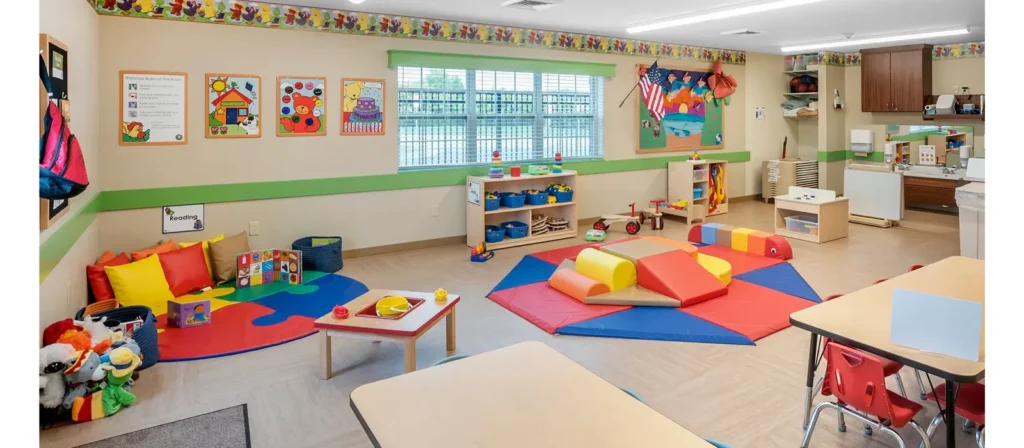
1. Define Clear Learning Areas
Organizing your classroom into specific zones helps students associate each area with a certain task or behavior. For instance, a reading nook should be quiet and calming, while an art corner can be colorful and stimulating. Labeling each space with signs or visual cues helps students understand expectations and build a routine.
2. Use Floor Tape to Mark Zones and Traffic Paths
Floor tape is a simple yet powerful tool for guiding students around the classroom. Use it to outline learning areas, define sitting spots, or direct movement around high-traffic areas like the sink or supply station. This not only prevents chaos during transitions but also supports students with spatial awareness or behavioral needs.
3. Rotate Themed Learning Zones Monthly
Keeping the classroom dynamic by changing themes in learning zones reinvigorates student interest. One month, your khu vực chơi kịch could be a farmer’s market; next month, a space station. Store props in labeled bins for easy rotation and reuse. This method supports creativity without constant remodeling.
4. Incorporate Flexible Seating Options
Offering a variety of seating choices—floor cushions, wobble stools, and standing desks—empowers students to choose what supports their focus and comfort. Organize the seating area with visual markers or matching baskets for materials, so the flexibility doesn’t lead to disorganization.
5. Leave Open Floor Space for Group Work and Movement
Avoid overfilling the classroom. An open floor area gives you the flexibility to conduct group activities, mindfulness sessions, or hands-on experiments. It’s especially helpful in early childhood classrooms where students work and move more freely on the floor.
Classroom Storage and Supplies Management
Efficient storage keeps materials accessible and the classroom tidy. When students and teachers can easily find and return what they need, it saves time, reduces frustration, and promotes responsibility.

6. Use Color-Coded Bins for Subject Materials
Assign a color to each subject—blue for reading, green for math, red for science—and use matching bins or labels throughout the room. This visual consistency makes it easy for students to return items to the correct location and quickly find what they need during independent work.
7. Add Picture-Text Labels to All Supplies
To support emerging readers and ELL students, label everything with both words and images. Label your glue bin with the word “Glue” and a glue stick icon. Over time, these labels support vocabulary development and reduce the number of “Where does this go?” questions.
8. Install Vertical Pegboards for Tools
Vertical pegboards are ideal for storing frequently used tools like scissors, clipboards, and headphones. Outline the shape of each item on the board so students can easily return them to the right spot. This also helps you quickly identify missing items.
9. Provide Personal Drawers or Bins for Students
Designate a small storage drawer or bin for each student to store their notebooks, folders, and personal items. This teaches responsibility and minimizes lost items. Use names and icons for easy identification, and rotate cleaning and organizing time into your weekly routine.
10. Organize Center Materials in Clear Drawer Towers
Store learning center materials in stackable drawers labeled by subject or activity. When it’s time for centers, students simply pull the drawer for their assigned task. Include visual instructions inside the drawer so students can manage the materials independently.
Teacher Organization Systems
Teachers juggle countless tasks every day. Having systems in place for planning, grading, and paperwork allows you to stay focused and reduces burnout. Your organization sets the tone for the entire classroom.
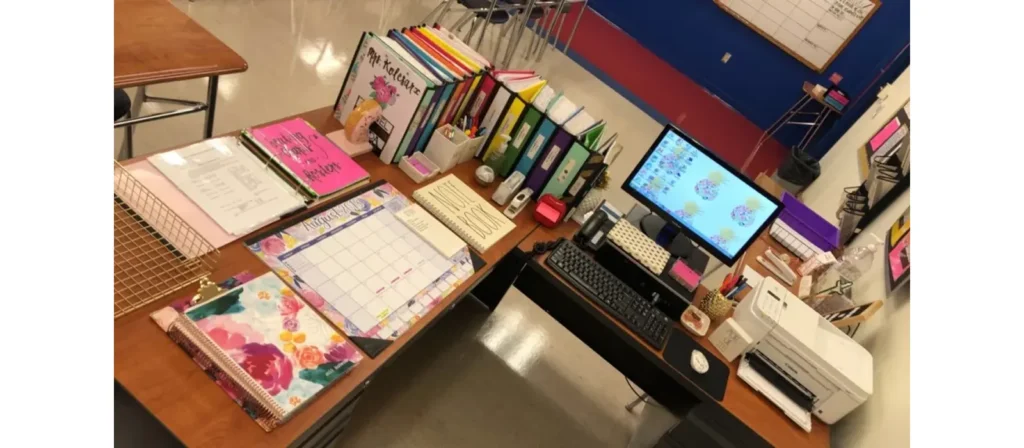
11. Set Up a Paperwork Tray System on the Teacher’s Desk
Having an “In,” “To Grade,” and “To Return” tray helps you handle paper flow efficiently. This system keeps your workspace clear and prevents papers from piling up or getting lost. Teach students where to place assignments so you spend less time sorting.
12. Use a Planning Binder or Digital Planning Tool
Keep your lessons, standards, assessments, and meeting notes in one organized binder or digital folder. If you’re using a digital option like Google Drive, create folders by month or unit. Having everything in one place reduces daily decision fatigue and saves time.
13. Create a Portable Grading Caddy
Fill a small caddy with your favorite pens, stickers, rubbers, and comment templates. Whether you’re grading during prep time or at home, this mobile solution ensures you have everything you need in one organized space.
14. Digitize Teaching Resources for Easy Access
Instead of bulky file cabinets, scan or download worksheets, lesson plans, and assessments into a digital folder. Organize by subject and date. Not only does this reduce clutter, but it also allows you to share resources easily with teammates or use them remotely.
15. Set Up a Weekly Prep Shelf or Cart
Designate a space in your room to prepare materials for the coming week. Label each day of the week and file handouts, center materials, or books accordingly. This system reduces last-minute scrambling and allows substitutes to step in more smoothly if needed.
Student Belongings Organization
Giving students clearly defined spaces for their personal belongings fosters independence, while predictable routines help maintain order and reduce transition stress.

16. Assign Labeled Backpack Hooks and Cubbies
Give every student a designated space to store their backpack, coat, and lunchbox. Use clearly labeled hooks and cubbies at child-friendly height. This avoids piles of bags on the floor and gives students a sense of ownership over their space.
17. Use Clear Zip Pouches for Personal Supplies
Distribute clear pouches for pencils, erasers, and scissors that stay in student desks or chair pockets. These keep essentials within reach while limiting clutter. Students are more likely to care for their tools when they have a designated place.
18. Create a Rotating Classroom Job Chart
Assigning jobs like “Line Leader,” “Tech Assistant,” or “Board Cleaner” not only supports classroom function but also teaches responsibility. Use a rotating chart with student photos or name cards so everyone has a chance to participate and contribute.
19. Use a Visual Check-In or Attendance Board
A simple magnetic board or pocket chart where students move their name upon arrival can double as an attendance tool and morning routine. This helps students transition into the school day with purpose and gives you a quick visual of who’s present.
20. Play Music to Signal Routine Transitions
Train students to associate songs or sounds with specific routines, such as clean-up, lining up, or rotating centers. This reduces verbal reminders and creates a calm, consistent flow to the day, especially helpful in early grades.
Teaching Materials and Visual Displays
Walls and surfaces are valuable real estate in any classroom. Use them strategically to reinforce learning objectives, reduce cognitive overload, and celebrate student success.
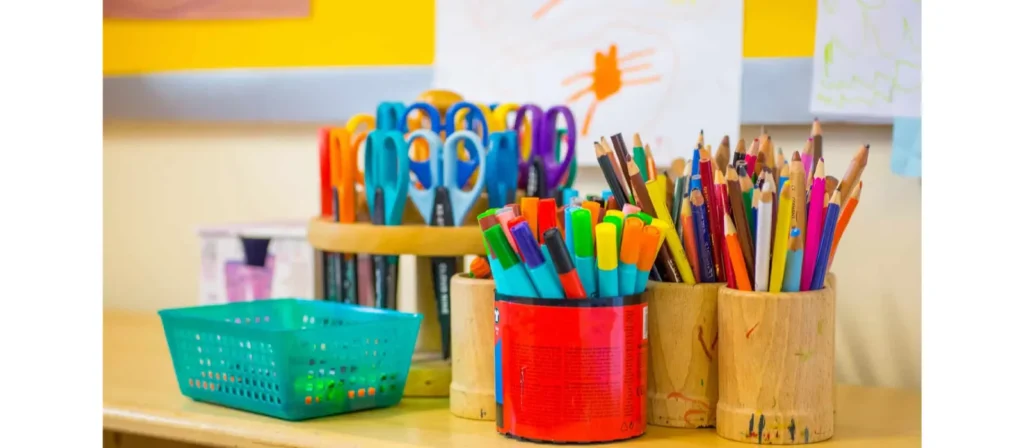
21. Display Pocket Charts for Daily Skills
Pocket charts can be used for spelling words, number patterns, or sentence construction, and changed out regularly. Their flexibility makes them a staple of organized instruction. Place them at student eye-level so learners can interact with them independently.
22. Hang Anchor Charts on a Rotating Clothesline
Rather than filling every wall, string a clothesline across your room and use clothespins to hang anchor charts. Rotate them based on your current unit or skill focus, keeping the classroom relevant and visually manageable.
23. Build an Interactive Word Wall
Design your word wall with Velcro or magnets so students can take down and use the words in their writing or activities. This transforms your display into a working tool, rather than static decor.
24. Dedicate a Board for Student Work
Reserve a bulletin board to showcase student art, writing, or projects. Rotate the display frequently so all students feel seen and valued. Group the work by theme or subject and use labeled headers for clarity.
25. Store Task Cards in Labeled File Boxes
Use photo boxes or plastic containers to store sets of task cards for centers or early finishers. Sort them by subject or skill and label clearly. This makes independent or small-group work easy to assign and retrieve.
Digital and Technology Organization
Digital tools are essential, but unmanaged tech can quickly create chaos. Having systems for devices, cords, and digital files ensures technology supports learning instead of disrupting it.

26. Set Up a Numbered Charging Station
Use a multi-port charging unit and number each plug to match numbered devices. This reduces cable confusion and helps students be responsible for returning devices to the correct spot.
27. Use QR Codes to Distribute Digital Content
Create QR codes that link to websites, digital worksheets, or videos. Display them on the board or print them out. This gives students instant access to materials without needing to type long URLs.
28. Organize Digital Files with Clear Folder Structures
On your computer or cloud drive, sort materials into consistent folder systems by subject, unit, or month. Name files clearly with dates and topics so you never lose track of your resources.
29. Maintain Digital Student Portfolios
Create individual folders (digital or physical) to collect writing samples, assessments, and progress reflections. These portfolios make it easier to communicate with families and track growth over time.
30. Use Digital Timers and Schedules on the Board
Project a visual timer or daily schedule onto your screen or smartboard. This keeps students aware of how much time remains in an activity and reinforces daily routines without constant verbal redirection.
Hãy gửi tin nhắn cho chúng tôi nếu bạn có bất kỳ câu hỏi nào hoặc yêu cầu báo giá. Các chuyên gia của chúng tôi sẽ trả lời bạn trong vòng 48 giờ và giúp bạn chọn đúng sản phẩm bạn muốn.
Classroom Organization of Different Areas
Effective classroom organization begins with intentional spatial zoning. Dividing the classroom into clearly defined areas not only helps manage behavior and flow but also supports targeted learning experiences. Each area should be designed to serve a specific instructional or developmental purpose, with giải pháp lưu trữ and materials tailored to the activities that occur there.
Góc đọc sách trong lớp học
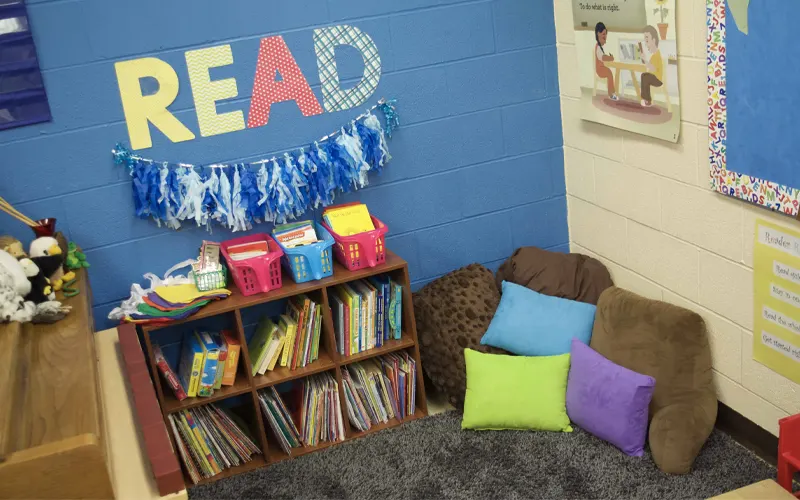
Purpose:
The reading corner is a quiet, inviting space that promotes independent reading, storytime, and language development. It encourages children to develop a love for books in a calm and comfortable setting.
Organization Strategies:
Position the reading corner away from high-traffic zones to reduce noise and distractions. Use soft seating like bean bags, floor cushions, or child-sized sofas. Display books with covers facing out using forward-facing bookshelves, which makes book selection more engaging. Rotate books every few weeks based on themes, seasons, or student interest to maintain variety and curiosity.
Recommended Storage Products:
- Forward-facing wooden book display shelves
- Soft baskets or cloth bins for themed book rotations
- Low bookshelves with labeled sections by genre, author, or reading level
- Fabric pockets or hanging organizers for read-aloud or teacher-favorite books
Classroom Math Zone

Purpose:
This zone supports hands-on math learning, fine motor skill development, and spatial reasoning. It typically includes math manipulatives, puzzles, counting tools, and task cards.
Organization Strategies:
Store materials in transparent containers with both visual and written labels. Keep commonly used items like counters, linking cubes, and dice at eye level so students can access them independently. Create “grab-and-go” task bins with ready-to-use activities for early finishers or small group instruction. Group tools by concept (e.g., measurement, place value, geometry).
Recommended Storage Products:
- Stackable clear plastic drawers or trays
- Tabletop drawer organizers for smaller items like dice or number tiles
- Plastic compartment boxes for sorting manipulatives
- Labelled lidded bins on open shelving
Classroom Writing Center
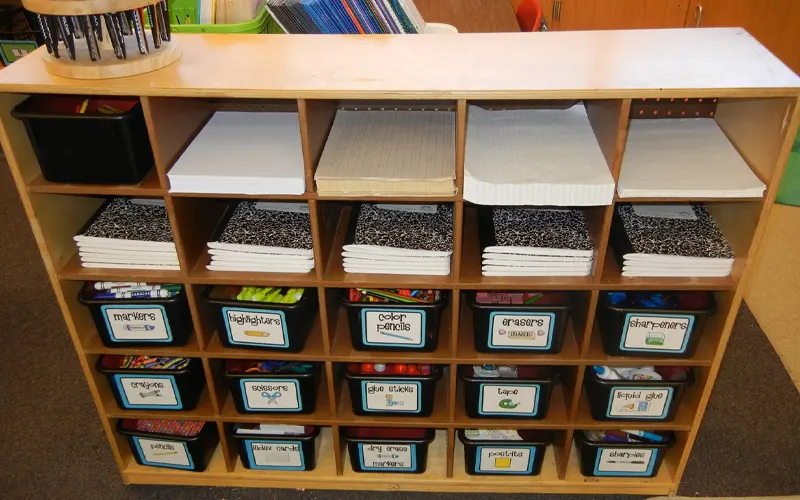
Purpose:
The writing center gives students a dedicated space to practice handwriting, spelling, and creative writing. It encourages both structured and open-ended language development.
Organization Strategies:
Keep a variety of paper types, writing utensils, word lists, and prompt cards within reach. Use small drawer units or baskets for separating materials. Post anchor charts for letter formation or sentence starters on the wall nearby. Rotate writing prompts and tools to match seasons, holidays, or current classroom themes.
Recommended Storage Products:
- Desktop paper organizers or magazine holders
- Pencil caddies and pen jars
- Three-drawer plastic organizers labeled for paper types (blank, lined, graphic organizers)
- Wall-mounted document trays for incoming/outgoing writing tasks
Art and Craft Station
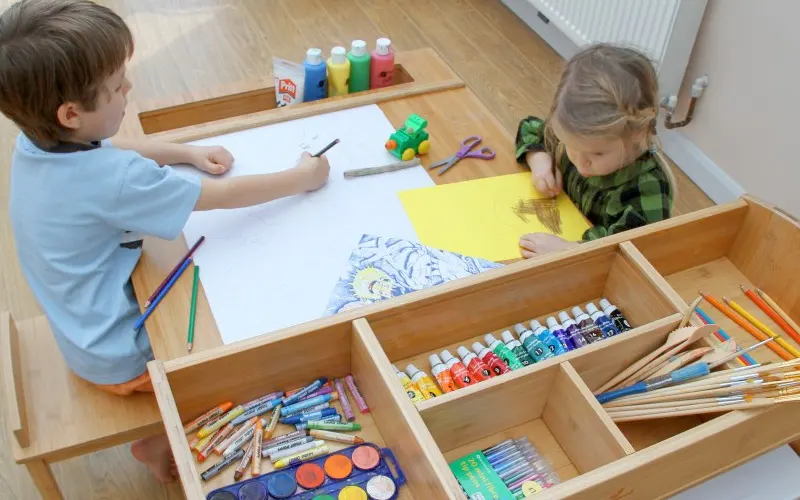
Purpose:
The art area allows students to explore creativity, self-expression, and fine motor skills through drawing, painting, building, and crafting.
Organization Strategies:
Use open shelving to store materials like markers, scissors, glue, and paper in labeled containers. Set up a drying rack for wet artwork and hang visual instruction posters or process guides nearby to support independent creation. Materials should be organized by medium and clearly marked with images for younger students. Include a “recycled art” bin for sustainable loose parts.
Recommended Storage Products:
- Art caddies or divided trays for tabletop use
- Rolling carts with multiple drawers for paints, brushes, and embellishments
- Wire or mesh drying racks
- Wall-mounted pegboard with baskets and hooks
STEM or Makerspace Area
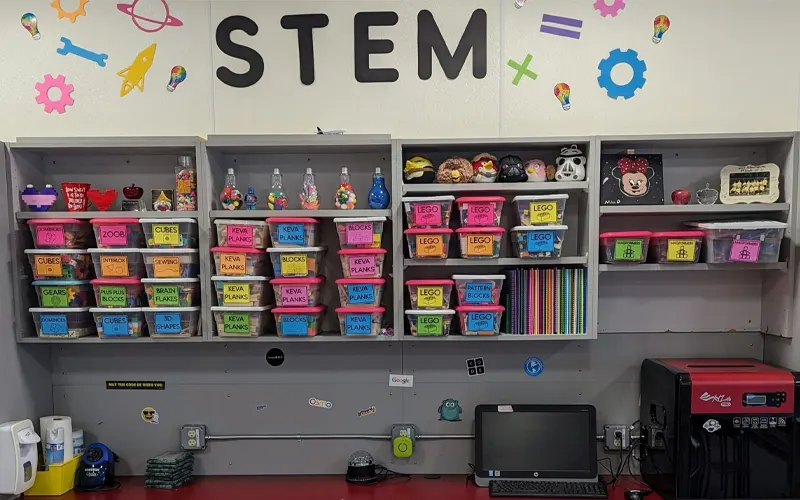
Purpose:
This space encourages engineering, innovation, science exploration, and problem-solving. It typically includes building materials, robotics kits, and hands-on tools.
Organization Strategies:
Divide classroom supplies by category: building (e.g., LEGO, blocks), engineering (e.g., tools, tape, measuring devices), and science (e.g., magnifying glasses, test tubes). Provide project trays or bins for unfinished work and organize tools on pegboards for easy visibility. Include instructions or challenge cards for self-guided exploration.
Recommended Storage Products:
- Labeled shoebox-size plastic bins for small parts
- Drawer towers for grouped activity kits
- Pegboards with outlined shapes for tools (wrenches, pliers)
- Stackable trays labeled “In Progress” and “Completed Projects”
Khu vui chơi kịch tính

Purpose:
Dramatic play supports social-emotional development, role-playing, and language skills. This zone often mimics real-world settings like kitchens, grocery stores, or medical offices.
Organization Strategies:
Create modular setups that can easily change themes. Store props like costumes, dishes, or fake food in labeled baskets or tote bins. Use shelves or dressers to mimic real furniture and give students the tools to reset the area themselves after playtime. Limit items per theme to avoid overwhelming the space.
Recommended Storage Products:
- Woven or fabric bins for thematic props
- Toy chests with safety hinges
- Low cubby units or open wardrobe racks for hanging costumes
- Velcro charts or sign-in boards for role assignments
Sensory Play Area
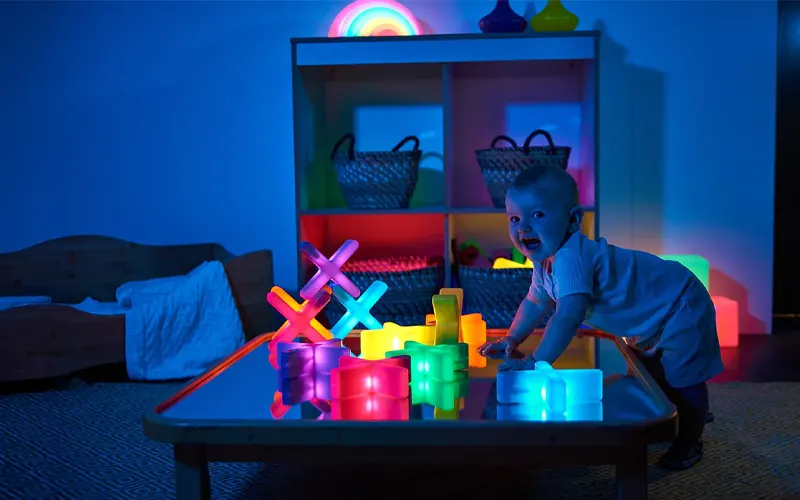
Purpose:
The sensory play area supports young children’s development by engaging their senses through hands-on exploration. It promotes focus, fine motor coordination, and emotional regulation, and is especially beneficial for children with sensory processing needs.
Organization Strategies:
Designate a quiet, low-traffic corner for sensory play. Use shallow trays or tables to contain materials like kinetic sand, water beads, or textured items. Rotate fillers weekly to maintain interest and store backups in sealed, labeled bins nearby. Visual boundaries—such as floor mats or shelf dividers—help define the space and minimize mess. Keep cleaning supplies close and establish clear clean-up routines to reinforce hygiene.
Recommended Storage Products:
- Lidded plastic bins for rotating sensory materials
- Sensory tables with removable tubs
- Low shelving units with labeled baskets
- Mesh bags or zip pouches for fidget tools and tactile objects
- Waterproof mats to protect floors during messy play
Science and Nature Area
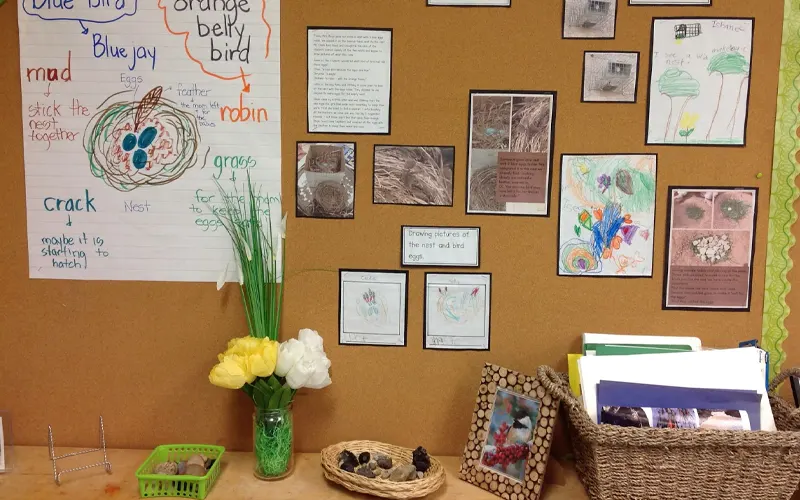
Purpose:
The science and nature area encourages curiosity, observation, and inquiry. It gives students a space to explore natural objects, conduct simple experiments, and engage in early scientific thinking such as classification, prediction, and comparison.
Organization Strategies:
Place this area near a window, if possible, to allow for natural light and access to outdoor views. Use display shelves or trays to showcase items like rocks, shells, leaves, or small animal models. Provide magnifying glasses, tweezers, and journals to support exploration. Keep thematic materials (e.g., weather tools, life cycle models) in labeled bins, and rotate based on seasonal or unit topics. Include laminated prompt cards to guide observation and questioning.
Recommended Storage Products:
- Clear bins for categorizing natural materials by type
- Small display stands or specimen trays
- Tool baskets for magnifiers, clipboards, and tweezers
- Wooden shelving units for showcasing rotating collections
- Plastic drawer units labeled by theme (plants, animals, space, etc.)
Technology Area

Purpose:
This area is designed for students to access digital learning tools such as tablets, laptops, or interactive whiteboards. It supports research, skill practice, and tech literacy.
Organization Strategies:
Ensure all devices are clearly labeled and assigned by number. Set up a charging station with cable organizers or shelves. Headphones should be stored in individual bags or hooks. Post a digital usage chart and screen-time rules near the area.
Recommended Storage Products:
- Multi-port charging station with labeled slots
- Cable management trays or binder clips for cords
- Hooks or wall pegs for headphones
- File boxes for student login cards and device rules
Teacher Workstation
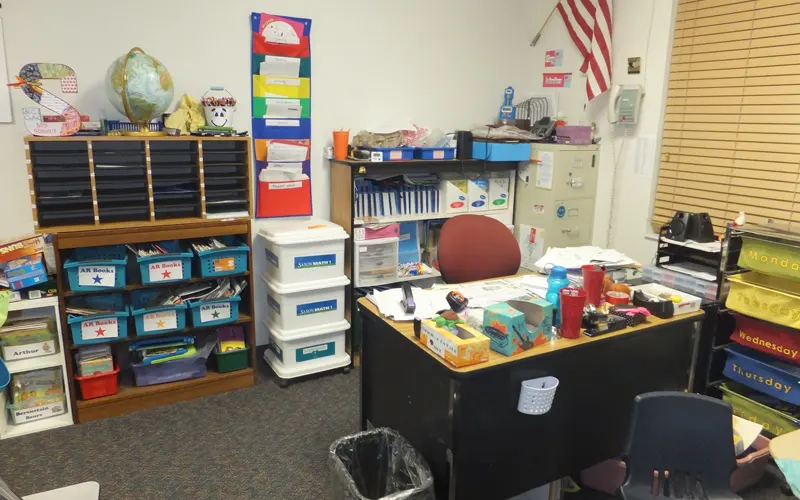
Purpose:
The teacher workstation serves as the central hub for instructional planning, documentation, classroom management tools, and personal teaching supplies. It should support efficiency, minimize clutter, and maintain easy access to essential materials throughout the day.
Organization Strategies:
Position the teacher workstation in a low-traffic area but with a clear line of sight to the whole classroom. Use drawer organizers to sort pens, stickers, paper clips, and other small tools. Store lesson plans, assessments, and files in binders or labeled magazine holders. Incorporate a multi-tier tray system for organizing paperwork. Keep personal items and confidential materials in lockable drawers or cabinets. Use a portable teacher caddy for moving between desks or taking materials home.
Recommended Storage Products:
- Multi-drawer desktop organizers for office supplies
- Lockable filing cabinet or rolling pedestal drawer
- “In/Out/Grade” letter tray system
- Teacher planner stand or desktop document rack
- Mobile teaching caddy with compartments for daily essentials
- Wall-mounted pocket file holder for attendance sheets or behavior logs
Classroom Organization for Different Ages
Classroom organization isn’t one-size-fits-all. Students’ developmental stages greatly influence how they interact with their environment, materials, and routines. By tailoring organizational systems to match students’ cognitive, motor, and emotional maturity, teachers can create classrooms that feel intuitive, accessible, and empowering.
1. Classroom Organization: Toddlers (Ages 1–3)
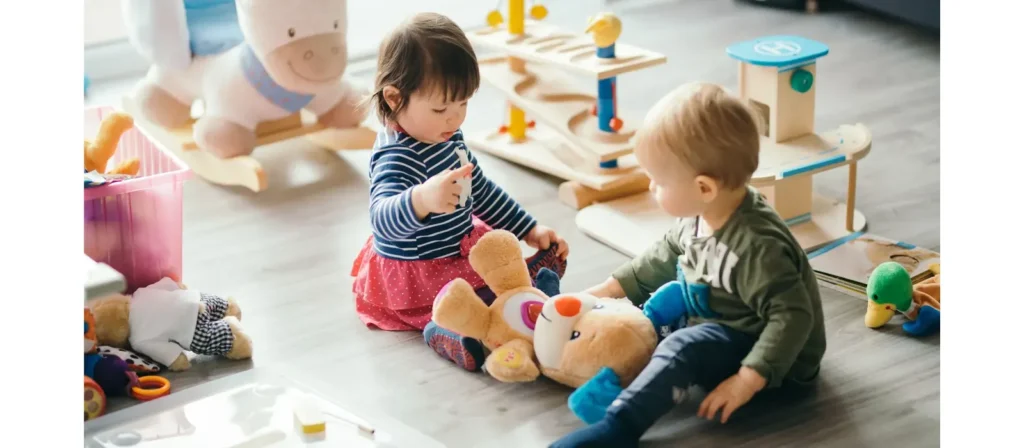
At this age, children are in constant motion and learning through sensory play. Classrooms should be open, with wide walking paths and minimal clutter. Furniture should be low and stable, and materials must be limited, safe, and rotated regularly to avoid overstimulation.
Organization Tips:
- Use open shelving with no more than 2–3 baskets per shelf.
- Store toys in shallow bins that toddlers can access and return independently.
- Clearly define play areas (e.g., block zone, sensory mat, quiet nook) using rugs or low dividers.
- Visual cues such as picture labels and photo-based clean-up charts are helpful.
Recommended Products:
- Soft-sided bins for toys
- Low, open book displays
- Toddler-height cubbies
- Non-slip floor mats for sensory or gross motor play
2. Classroom Organization: Preschool (Ages 3–4)
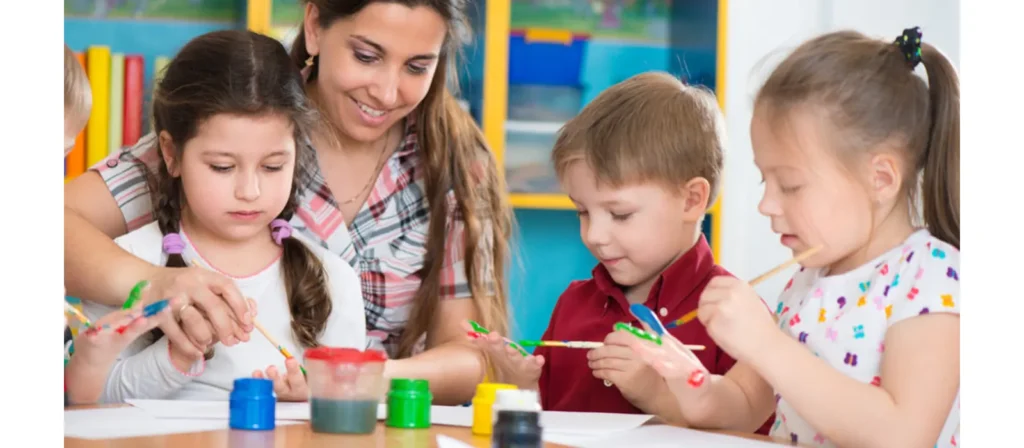
Preschoolers begin to follow routines, make choices, and engage in small-group play. The classroom should be structured to encourage independence, with consistent organization systems and clearly labeled areas.
Organization Tips:
- Create defined zones for reading, art, dramatic play, and blocks.
- Use color-coded bins and picture-word labels to reinforce sorting and returning habits.
- Rotate materials every few weeks to keep interest high and reduce clutter.
- Introduce job charts and visual schedules to support predictability.
Recommended Products:
- Cubby shelves with individual name tags
- Mobile carts for rotating centers
- Laminated visual schedule strips
- Art drying racks and tabletop supply caddies
3. Classroom Organization: Pre-K (Ages 4–5)
Pre-K students are ready for more complex routines and early academic centers. Organizational systems should support structured learning while allowing for creativity and movement.
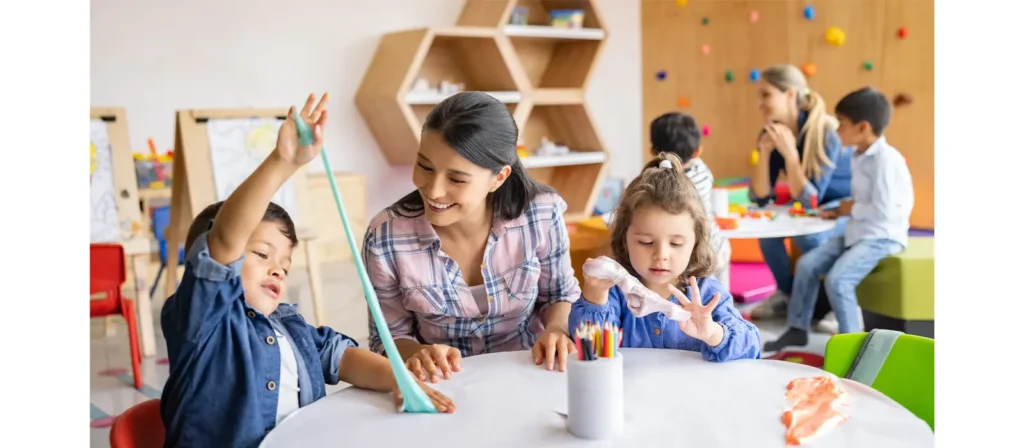
Organization Tips:
- Provide individual supply bins for writing tools and folders.
- Use task drawers or labeled trays for center activities.
- Establish a check-in/out system for activities or responsibilities.
- Build in clean-up time as part of the learning schedule.
Recommended Products:
- Color-coded drawer towers for learning centers
- Hanging pocket charts for vocabulary or jobs
- Visual instruction cards are at each center
- Clear bins with lids for math manipulatives or science tools
4. Classroom Organization: Kindergarten (Ages 5–6)
Kindergarteners thrive with routines, visual systems, and personal responsibility. The classroom should provide both structure and freedom, with individualized storage and accessible group areas.
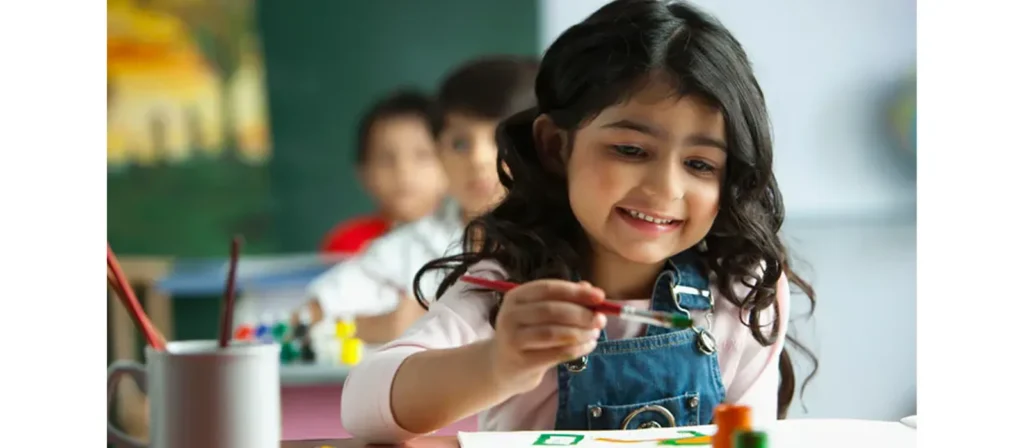
Organization Tips:
- Assign personal cubbies or desks with labeled organizers.
- Set up weekly folder systems for classwork and take-home materials.
- Keep frequently used supplies in shared table bins for collaboration.
- Incorporate charts, routines, and timers to reinforce time management.
Recommended Products:
- Desk organizers and chair pockets
- Color-coded folders for take-home/return items
- Table caddies for group supplies
- Behavior and job charts with magnets or clips
5. Classroom Organization: Elementary (Ages 6-10)
Elementary students need tools to manage increasing academic demands. They can follow multi-step instructions and use planners, charts, and personal systems. Group and independent work areas should be clearly designated.
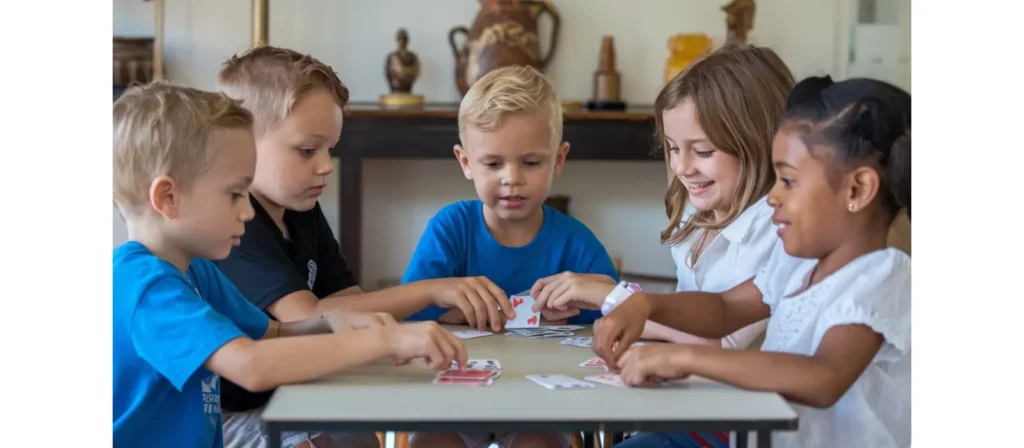
Organization Tips:
- Provide student binders, planners, or folders for each subject.
- Post daily objectives and visual schedules on the board.
- Use bins and file systems for early finisher work, homework, and extra supplies.
- Train students to be responsible for maintaining shared areas.
Recommended Products:
- Desktop file boxes or vertical organizers
- Color-coded subject folders
- Portable supply boxes
- Group table bins and anchor chart stands
Essential Tools and Supplies for Classroom Organization
A well-organized classroom doesn’t require expensive furniture or fancy equipment—it relies on the smart use of practical tools that support order, accessibility, and routine. The right organizational supplies help both teachers and students manage materials efficiently, reduce clutter, and create a structured learning environment. Below are essential categories of tools and recommended items every classroom should have to maintain daily organization.
1. Storage Bins and Containers
Well-labeled, modular storage is the foundation of classroom organization. Clear containers help students see contents at a glance, while stackable and color-coded options allow you to optimize space and keep materials grouped by subject or theme.
- Clear plastic bins with lids – Ideal for storing manipulatives, sensory fillers, or seasonal props.
- Open baskets or fabric bins – Great for books, dramatic play materials, or quick-access items.
- Stackable drawer towers – Useful for center-based learning materials, art supplies, or task boxes.
- Label holders or adhesive labels – Include both text and visuals for student-friendly identification.
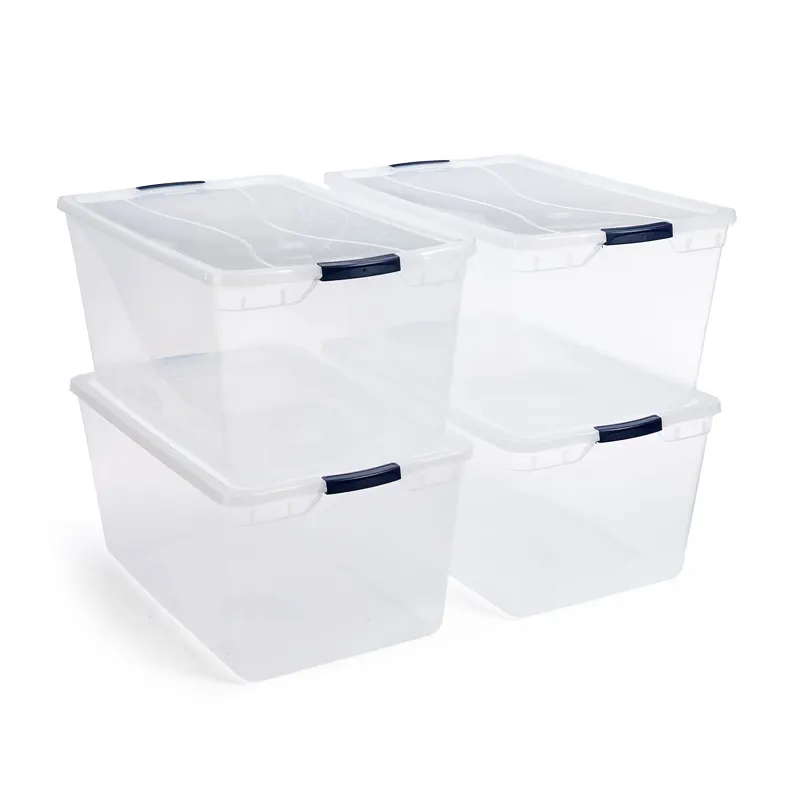
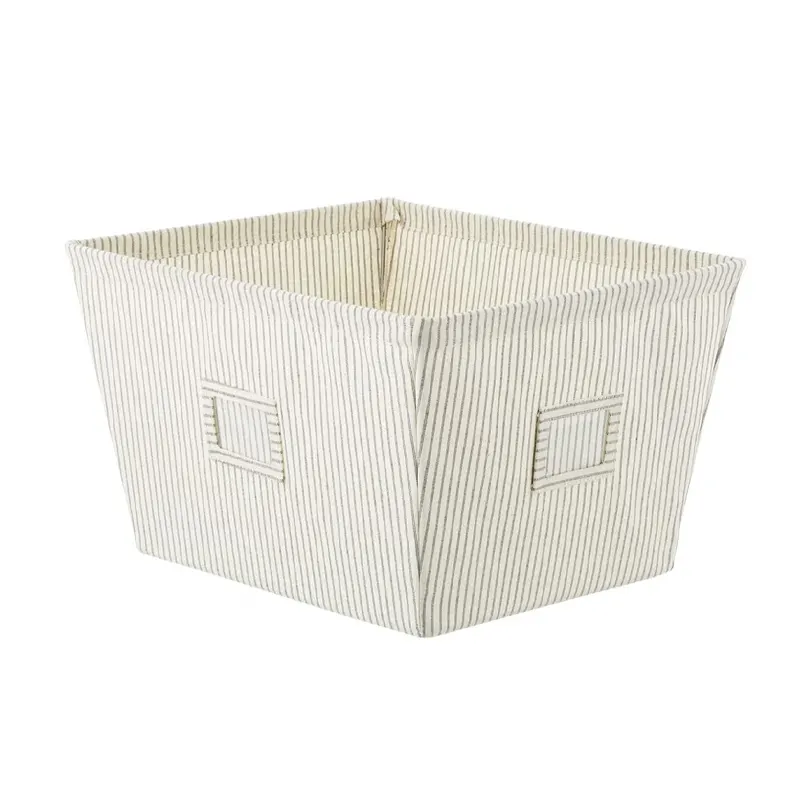
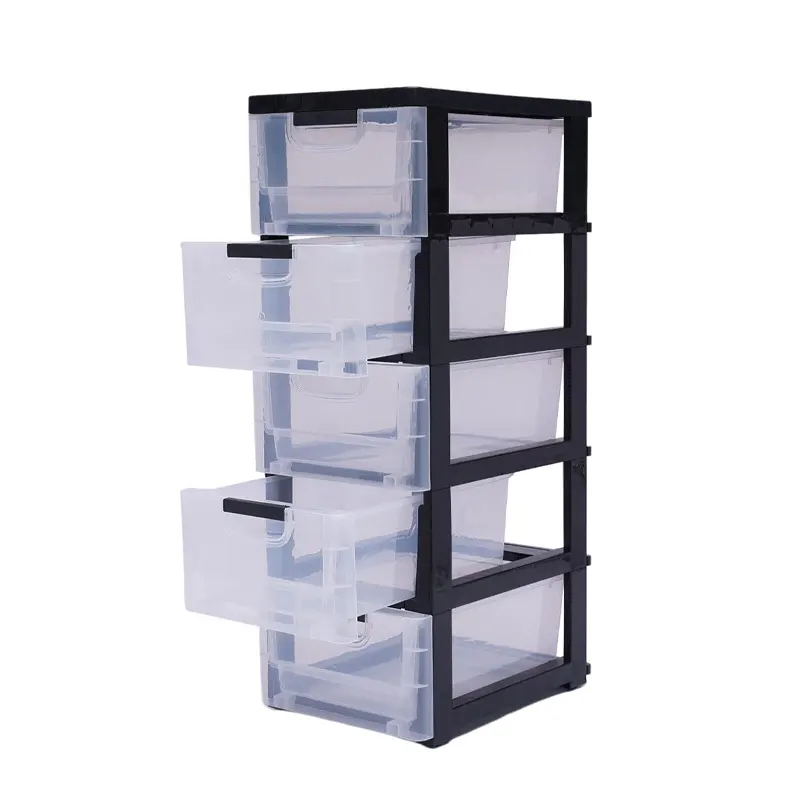
2. Paper and Document Organizer
Keeping paper flow organized—from assignments and handouts to newsletters and assessments—is essential. These tools help you separate what needs attention now from what can be filed or returned later.
- Letter tray systems (“In/Out/Grade”) – Keeps student work organized and streamlines grading.
- Magazine holders or vertical file racks – Perfect for organizing unit plans, subject folders, or leveled readers.
- Hanging wall file pockets – Useful near the door for permission slips, newsletters, or forms.
- Clipboards and folders with labels – Essential for small group data, behavior logs, or student portfolios.
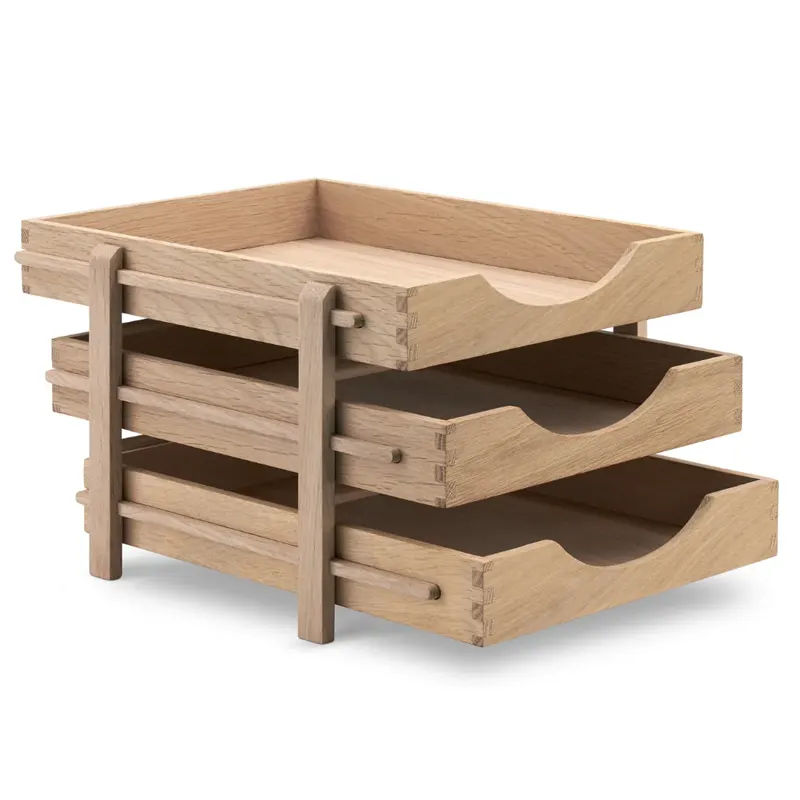
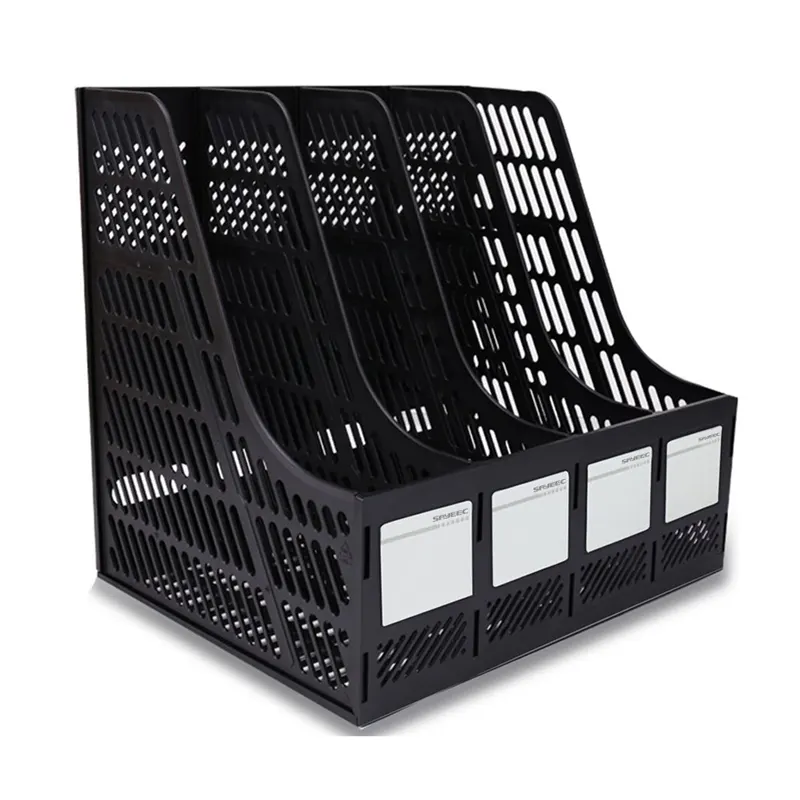
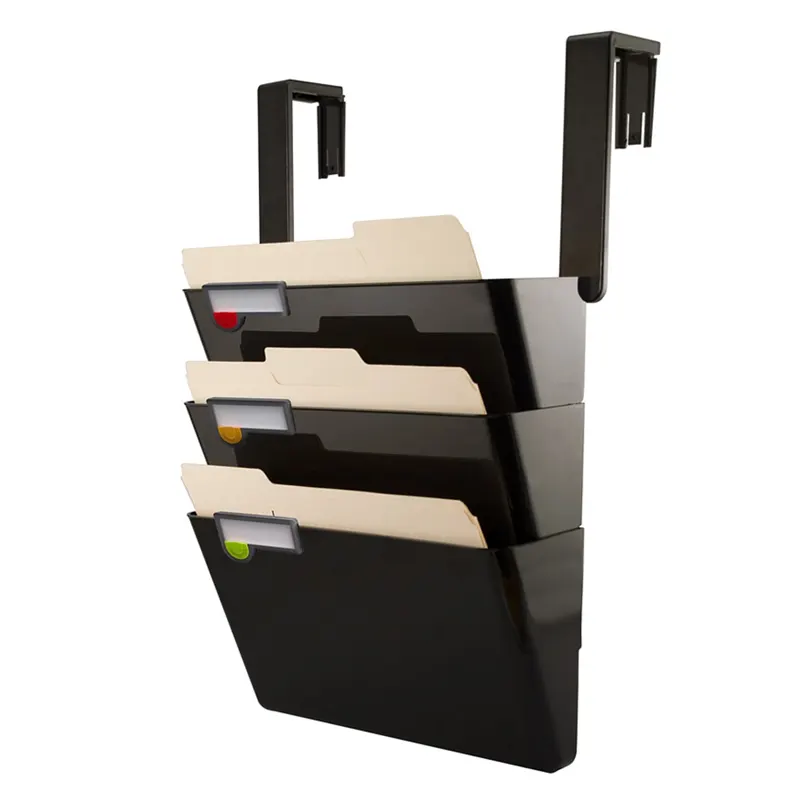
3. Labels and Visual Aids
Labels make systems sustainable. When students know exactly where things go, organization becomes a shared responsibility. Visual aids also support behavior, routines, and content retention.
- Picture-text labels – Support early readers and ELL students in finding and returning materials.
- Color-coded label systems – Assign colors to subjects, centers, or student groups for instant recognition.
- Laminated tags with Velcro or magnets – Reusable and ideal for frequently rotated bins or drawers.
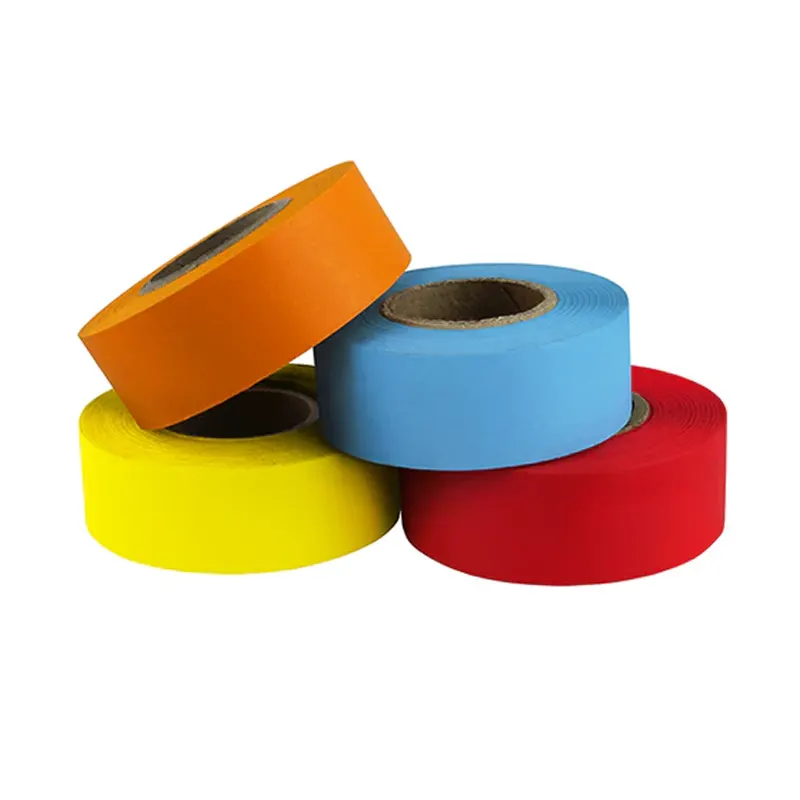
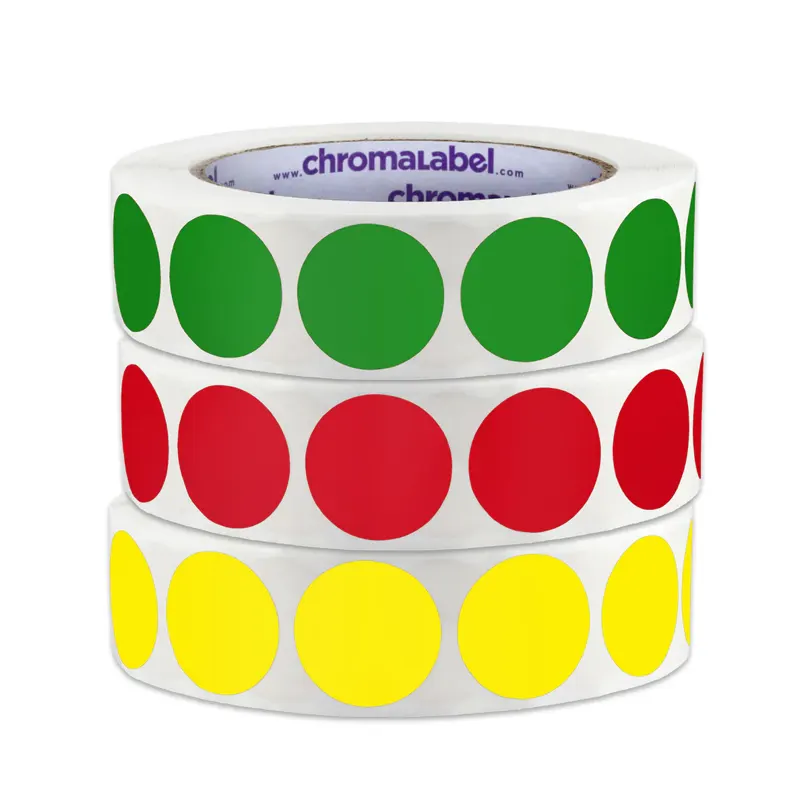
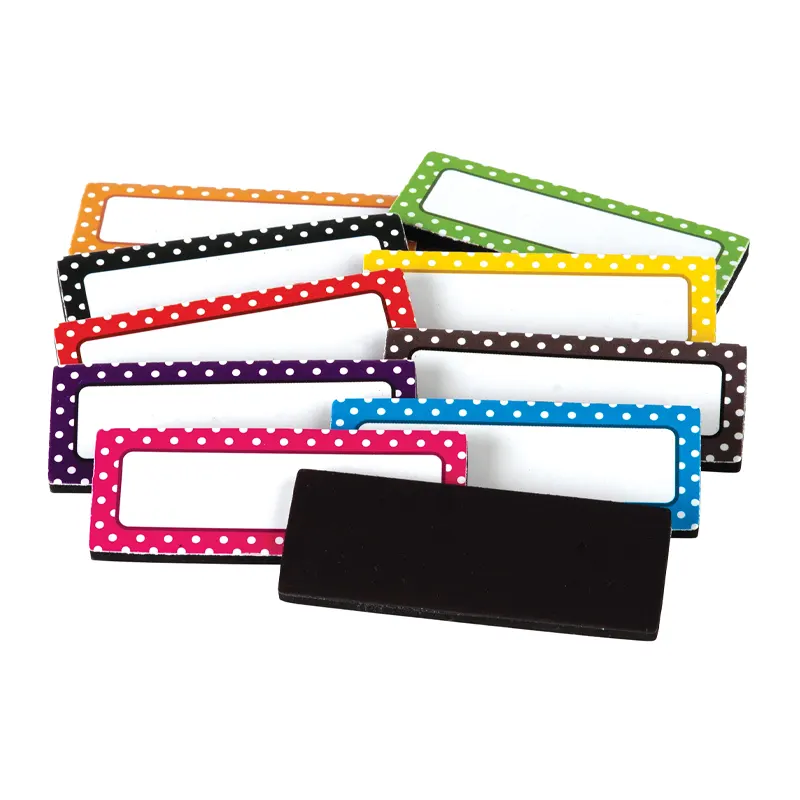
4. Teacher Tools and Planning Aids
Your workstation is the brain of your classroom. It should be equipped with tools that help you plan, grade, and store personal items efficiently, without letting clutter take over your space.
- Desktop caddy or supply organizer – Store pens, highlighters, sticky notes, scissors, and stamps.
- Weekly prep cart or shelf – Organize materials by day to streamline lesson delivery.
- Portable grading basket – Contains rubrics, comment slips, and finished work for review at home.
- Teacher planner (digital or paper) – Centralizes to-do lists, lesson plans, and schedules.
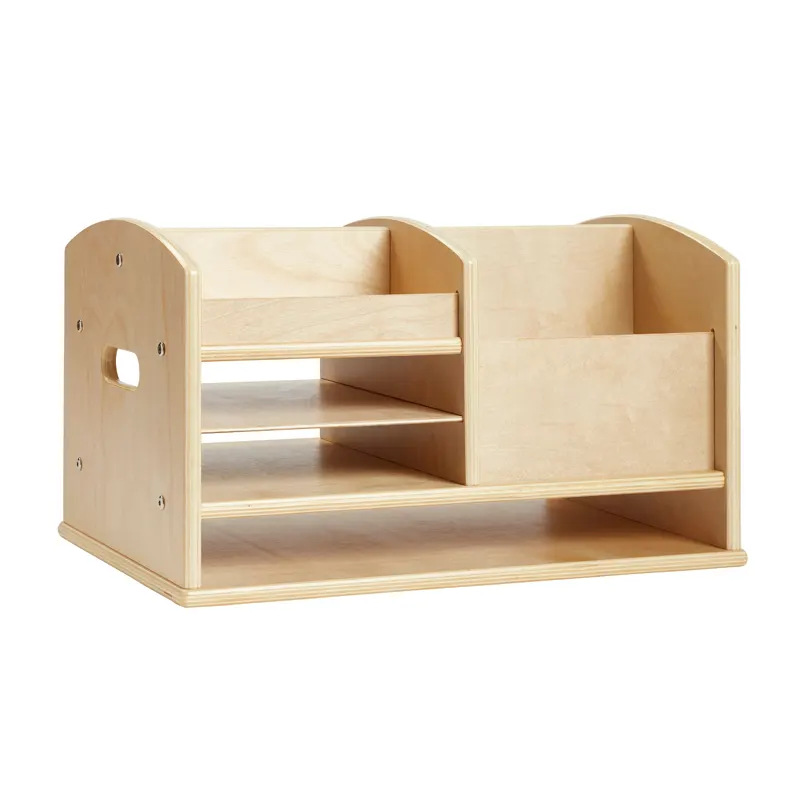
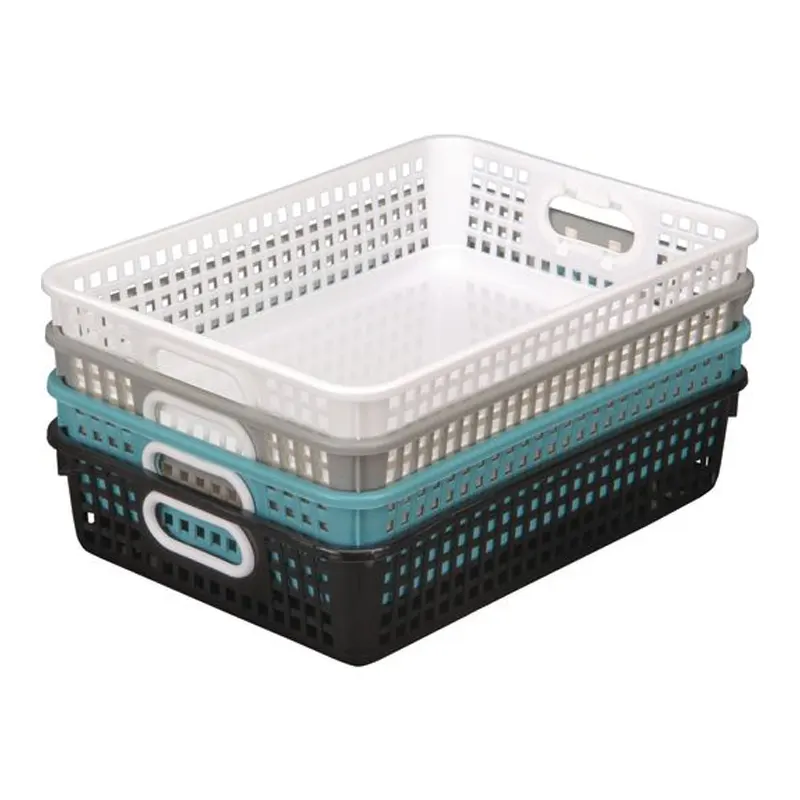
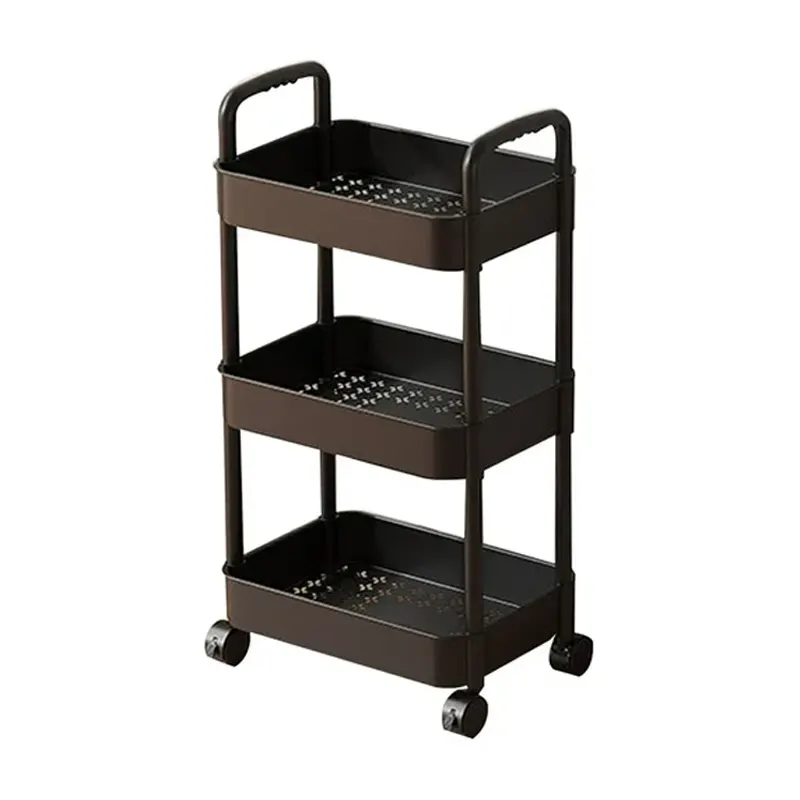
5. Technology and Digital Resource Storage
Managing digital devices is crucial for tech-integrated classrooms. The goal is to keep tools charged, accounted for, and easily accessible without creating a tangle of cords or confusion.
- Charging stations with numbered ports – Prevents cord tangles and lost devices.
- Tablet or laptop storage carts – Secure and transportable storage for student tech.
- Headphone hooks or labeled zip bags – Keep headsets sanitary and organized.
- QR code displays or tablet stands – For accessing digital activities or projecting schedules.
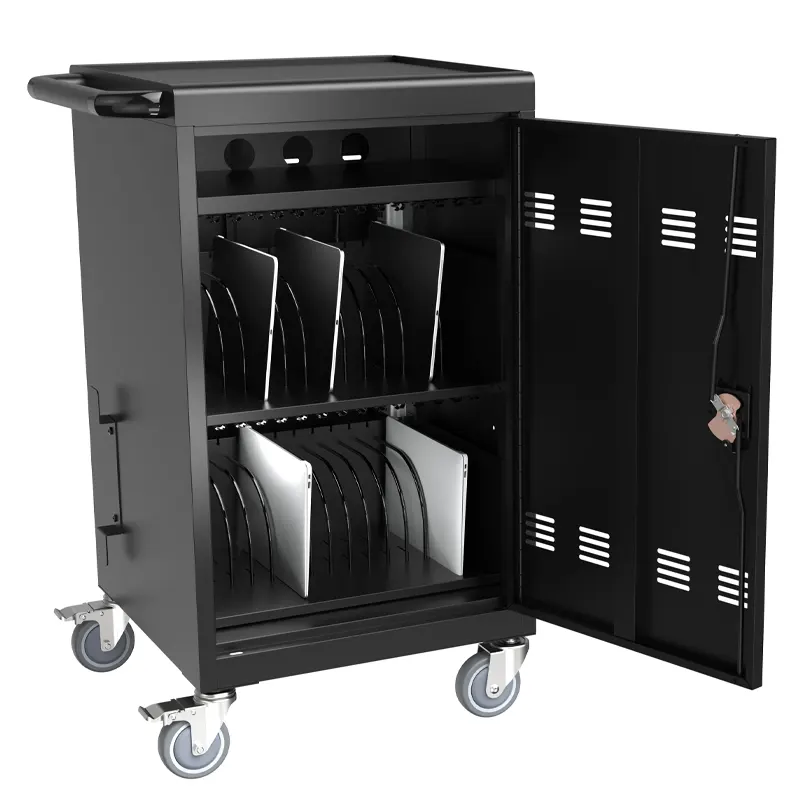

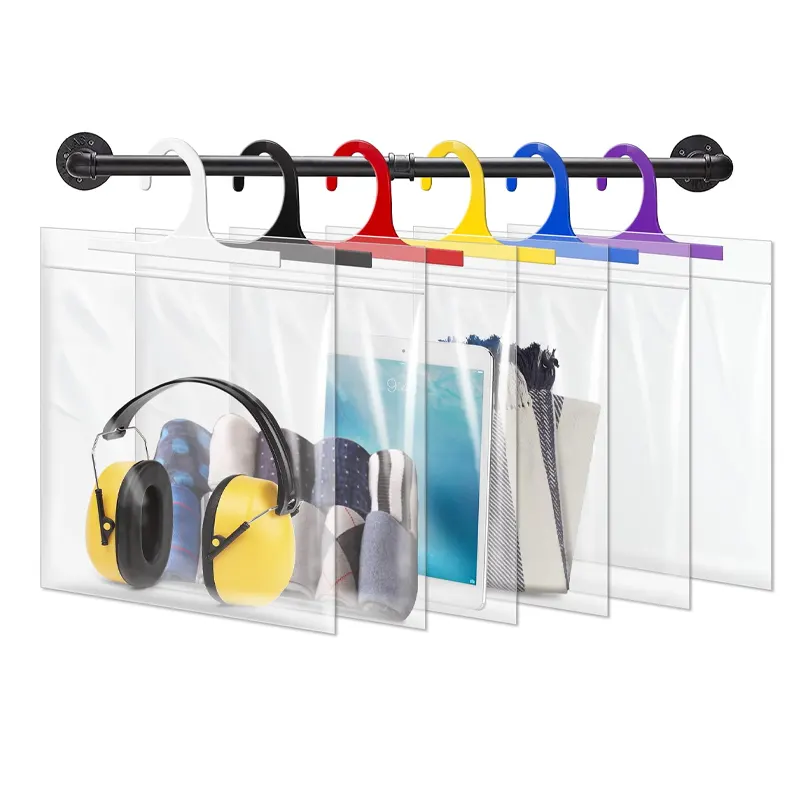
6. Center and Rotation Management Tools
Centers and small groups require ready-to-go materials stored intuitively so that students can engage with minimal teacher direction. Clear structure improves transitions and activity quality.
- Plastic task card boxes or photo cases – Keep instructions, prompts, and activity cards safe and sorted.
- Color-coded trays for center work – Easily distributed and collected by students.
- Mini whiteboards with dry-erase markers – Useful for reusable tasks and quick responses.
- Rotating organizer carousel or supply bins per group – Ensures each group has what they need.
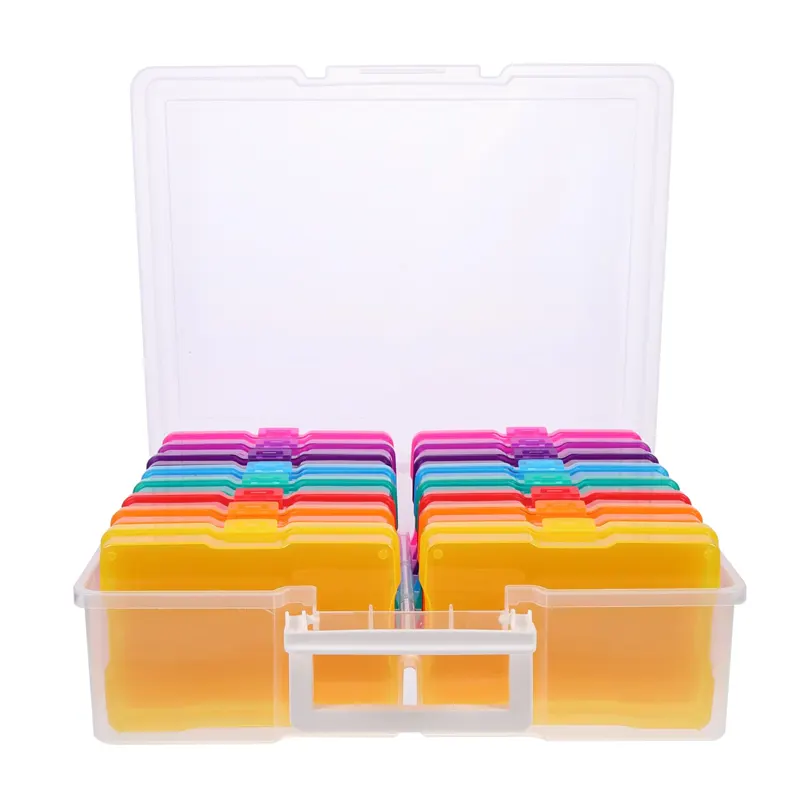
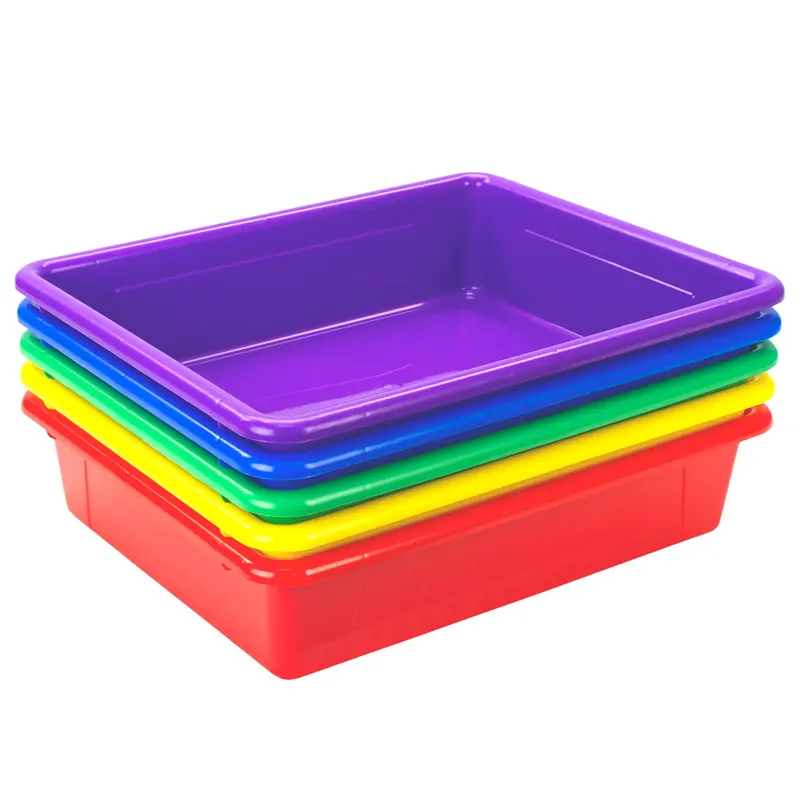
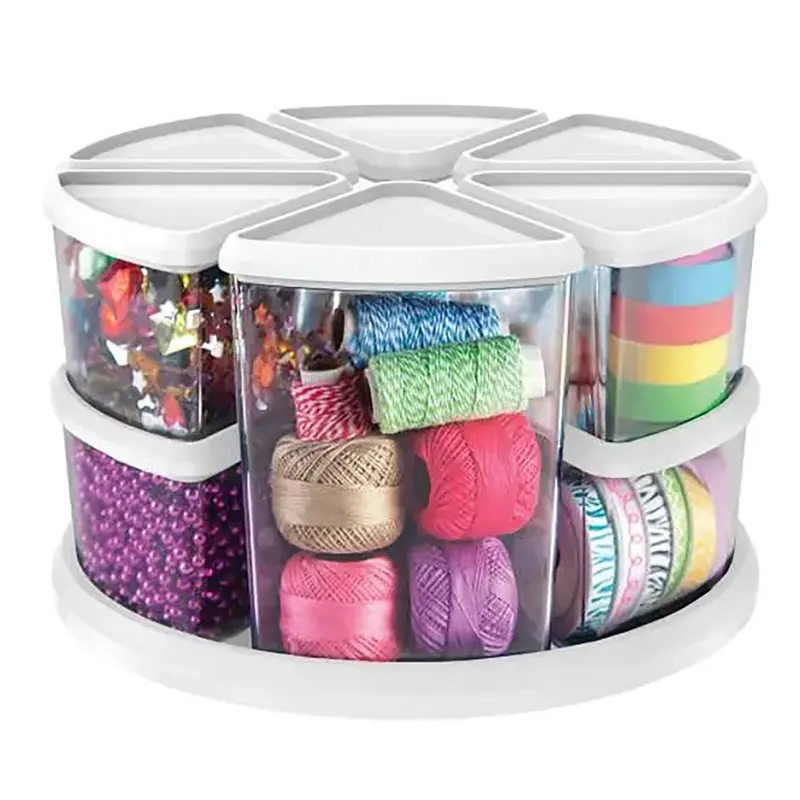
7. Behavior and Routine Aids
Routine-building visuals help students anticipate what’s next and move between activities with confidence. These aids also reduce repetitive instructions and improve classroom flow.
- Visual schedule boards or flip charts – Help students anticipate transitions and follow the daily plan.
- Clean-up checklists at stations – Encourage students to reset areas independently.
- Magnetic job charts or pocket cards – Make it easy to assign, track, and rotate classroom responsibilities.
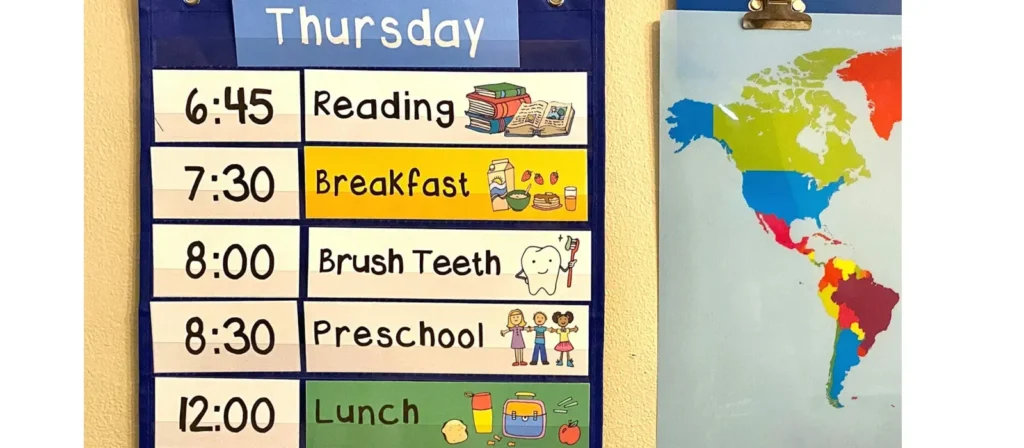
Hãy gửi tin nhắn cho chúng tôi nếu bạn có bất kỳ câu hỏi nào hoặc yêu cầu báo giá. Các chuyên gia của chúng tôi sẽ trả lời bạn trong vòng 48 giờ và giúp bạn chọn đúng sản phẩm bạn muốn.
Teaching Students Classroom Organizational Habits
Classroom organization isn’t just a teacher’s responsibility—it’s also a teachable skill. When students are explicitly taught how to organize materials, manage time, and follow procedures, they become more independent, focused, and confident learners. Embedding organizational habits into daily routines not only improves classroom flow but also helps students build lifelong executive function skills such as planning, self-monitoring, and responsibility.
1. Model Organizational Behavior
Children learn best by observing. Consistently model how to retrieve and return supplies, organize materials, and maintain clean spaces. Narrate your thought process aloud—“I’m putting the markers back in the blue bin so we can find them easily tomorrow”—to reinforce expectations. Demonstrate how to set up desks, prepare folders, and transition between tasks. Over time, students begin to mirror this structured behavior independently.
2. Establish Clear Routines and Procedures
Repetition builds habits. Set clear daily procedures for entering the classroom, unpacking, transitioning between activities, and cleaning up. Use visual schedules, checklist charts, and consistent verbal cues to reinforce routines. Introduce and practice these systems explicitly at the start of the year, then revisit and reteach as needed, especially after holidays or classroom changes.
3. Assign and Rotate Student Jobs
Giving students classroom responsibilities teaches ownership and builds community. Create a rotating job chart with tasks such as Materials Manager, Library Helper, or Technology Assistant. Provide visual instructions or job cards so students can follow through independently. Rotating jobs weekly or biweekly keeps students engaged and gives everyone a chance to contribute.
4. Use Visual Supports and Checklists
Visual reminders help students stay organized without constant verbal redirection. Post tidy-up checklists near centers, use “Ready to Learn” posters at student desks, or provide personal to-do lists for older students. Color coding or icons can support emerging readers and reduce reliance on teacher prompts.
5. Break Down Tasks and Scaffold Responsibility
Teach organizational skills progressively. Start with basic routines—returning supplies, labeling folders—then introduce more complex tasks like managing a weekly planner or organizing desk space. Break tasks into steps and guide students through them until they can complete them independently. Celebrate progress and give frequent feedback.
6. Label Student Tools and Spaces
Help students take ownership by labeling everything—folders, bins, cubbies, notebooks—so they can easily identify where things belong. Use pictures alongside words for younger learners or ELL students. This not only builds independence but also reduces teacher reminders and interruptions.
7. Teach Time Management and Planning
Organization isn’t just physical—it’s mental too. Teach students how to use daily planners, checklists, or visual schedules. For younger children, use picture-based task charts. For older students, introduce simple bullet journaling, weekly planners, or digital task trackers to encourage long-term planning and prioritization.
8. Integrate Organization into Academics
Weave organizational thinking into content lessons. For example, teach note-taking structures during writing, model how to sort materials by subject during science, or use graphic organizers in reading. This reinforces that the organization is not separate from learning—it’s part of how we learn effectively.
9. Encourage Reflection and Accountability
Create moments for students to reflect on their organizational habits. Use daily or weekly check-ins: “What went well today?” or “Did I keep my area clean?” Encourage students to set simple goals like “I will return my math folder without reminders.” Pair this with light accountability, such as sharing with a partner or marking a progress chart.
10. Reinforce Positive Organizational Behaviors
Acknowledge students who follow routines, keep materials organized, and help maintain order. Use specific praise: “I noticed Maya put away all her supplies without being asked—great self-management!” Consider using class points, stickers, or leadership badges to reinforce habits, especially during early habit formation stages.
Classroom Organization: Cleaning and Maintenance
| Tính thường xuyên | Tasks | Mục đích | Tips for Classroom Organization |
|---|---|---|---|
| Daily | – Wipe down desks and shared surfaces – Empty trash cans – Check supply stations for restocking – Ensure items are returned to labeled bins | Maintain a sanitary, clutter-free learning environment | Use student helpers for end-of-day cleanup; keep sanitizing wipes and a broom/dustpan easily accessible |
| Weekly | – Deep clean high-touch areas (door handles, light switches) – Disinfect shared supplies and tech tools – Organize paper trays, folders, and manipulatives – Clean out and reset small group or center materials | Prevent germ buildup and keep systems running smoothly | Assign rotating classroom jobs for supply sanitizing and area resets |
| Bi-Weekly | – Sort through student desks or cubbies – Replenish classroom supplies (tissues, pencils, markers) – Dust bookshelves and storage units | Keep student areas tidy and fully stocked | Use a checklist to track what needs restocking or replacing |
| Monthly | – Purge old or unused materials – Review and update classroom labels and signage – Clean out the teacher’s toolbox and planning space – Inspect furniture for wear or safety issues | Refresh classroom systems and prevent clutter buildup | Create a routine for monthly organizing tasks |
| Seasonal | – Rotate classroom displays and bulletin boards – Sanitize larger classroom equipment – Reorganize learning zones to reflect new units or seasons | Support curriculum transitions and maintain student engagement | Plan a seasonal classroom reset during breaks |
Digital Classroom Organization Strategies
As classrooms continue to integrate technology, the need for strong digital classroom organization has never been greater. A well-structured digital space supports smoother instruction, clearer communication, and more efficient learning—whether you’re teaching in-person, remotely, or in a hybrid setting. Below are key strategies to help you stay organized digitally, boost student accountability, and reduce tech-related chaos.
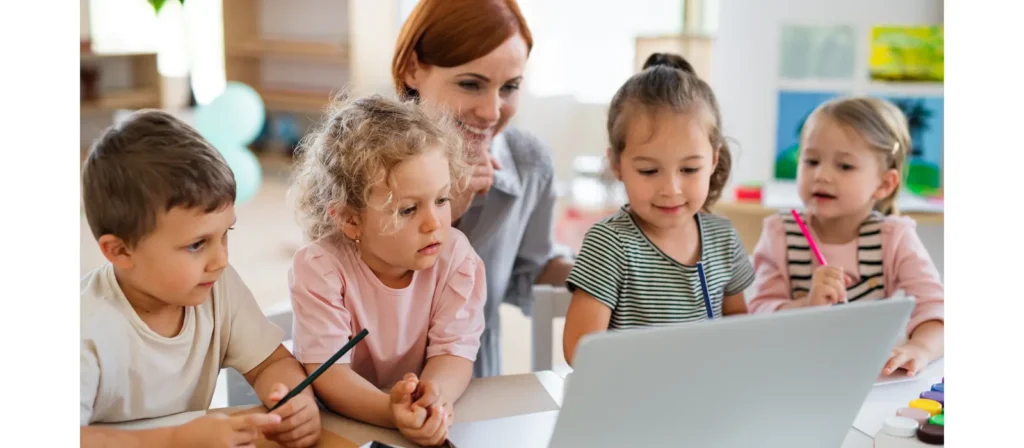
- Establish a Clear Folder Hierarchy
Create a consistent structure for organizing all digital teaching materials. Use folders for each subject, unit, or week, and maintain a naming convention that’s simple and chronological (e.g., “Week 5 – Writing Process”). This helps you and your students locate materials easily without scrolling endlessly. - Standardize Naming Conventions
Give every file, assignment, and resource a clear and consistent title. Avoid vague names like “Assignment 1” or “Lesson Today.” Instead, use detailed and predictable titles such as “Science_AnimalHabitat_Week3” or “Math_MultiplicationPractice_Oct10.” - Create a Central Digital Hub
Whether it’s a shared folder, a digital bulletin board, or a classroom homepage, establish one centralized space where students can access links, assignments, calendars, and updates. This eliminates guesswork and ensures that all students are on the same page. - Use Templates for Repetitive Tasks
Develop reusable digital templates for common documents like lesson plans, weekly overviews, rubrics, or student checklists. These templates save time and maintain consistency across your digital materials, reducing errors and duplication. - Utilize Visual Labels and Color Coding
Add icons, emojis, or color tags to folders and files to help categorize subjects, groups, or levels. Visual identifiers support faster navigation and are especially helpful for younger students or visual learners. - Set Weekly Routines for Digital Management
Dedicate time each week to digital organization. Clean out your desktop, archive completed work, and back up important files. Encourage students to do the same by modeling “digital reset” habits as part of classroom routines. - Organize Digital Student Submissions
Create folders for each student or class to collect their work in an orderly way. Clearly define where and how students should submit assignments, and teach them to name their files in a structured format like “FirstName_Subject_AssignmentTitle.” - Maintain a Digital “To-Do” List and Planner
Use digital task lists or calendars to keep track of due dates, planning cycles, grading schedules, and reminders. Simple, cloud-accessible tools help maintain focus and reduce last-minute stress, whether you’re at school or working remotely. - Group Resources by Purpose
Separate digital resources by type: assessments, instructional videos, worksheets, presentations, etc. Use subfolders to keep things categorized and searchable. This helps streamline lesson planning and makes sharing resources much easier. - Promote Digital Responsibility in Students
Teach students how to manage their own digital files. Model how to create folders, organize downloads, and clean out unnecessary documents. Set expectations for digital behavior just like you would for physical classroom routines.
Recommended Digital Classroom Management Platforms
- Google Workspace for Education: Cloud-based tools for creating, organizing, and sharing assignments with real-time collaboration.
- Microsoft Education (Office 365 + Teams): A secure suite for managing assignments, class communication, and structured digital learning.
- Seesaw: A student-friendly platform for digital portfolios, creative responses, and parent communication.
- Canvas: A comprehensive learning management system (LMS) for managing courses, grading, and learning modules.
- ClassDojo: A behavior and classroom management app that supports communication, routines, and student motivation.
- Notion:A customizable workspace for teachers to organize lessons, planning, and classroom resources in one hub.
- Edmodo: A secure social learning network where teachers can share content, distribute assignments, and manage communication.
- Schoology: A structured LMS that supports course creation, assessments, and collaboration with built-in analytics tools.
Common Classroom Organization Challenges and Solutions
Even the most experienced teachers encounter bumps in the road when it comes to maintaining effective classroom organization. From space limitations to student habits, certain challenges can quickly throw off your routine and lead to clutter, confusion, or wasted time. Below are some of the most common classroom organization problems—and simple, realistic solutions to get things back on track.

Challenge: Limited Physical Space
Giải pháp:
Maximize vertical space by installing shelves, wall hooks, or over-the-door organizers. Use classroom furniture that serves multiple purposes, like storage benches or rolling carts. Group materials by frequency of use—store everyday items within arm’s reach and seasonal items in higher, labeled bins. Go digital where possible to reduce paper clutter.
Challenge: Students Not Returning Materials Properly
Giải pháp:
Model how to return materials, and teach students the “why” behind each system. Use visual labels with pictures and words, especially for younger students or multilingual classrooms. Incorporate classroom jobs like “supply checker” to build accountability. Reinforce habits through praise and consistent reminders until routines stick.
Challenge: Too Much Paperwork and Piled-Up Student Work
Giải pháp:
Set up a clear system for incoming, in-progress, and completed student work using labeled trays or file boxes. Dedicate weekly time to grade, return, or file papers. Consider digital submissions when appropriate to reduce physical clutter. Use batch processing—grade all of one assignment type at once—for efficiency.
Challenge: Disorganized Centers or Learning Stations
Giải pháp:
Use color-coded bins or folders for each center. Create laminated instruction cards that remain with each station so students can work independently. Limit the number of materials at each station to reduce mess and confusion. Assign cleanup roles during center rotations to ensure a reset between groups.
Challenge: Classroom Cleanup Takes Too Long or Gets Chaotic
Giải pháp:
Establish a timed cleanup routine with a visual timer and specific cues. Play a short cleanup song to signal it’s time to tidy up. Assign each student or group a specific task (e.g., floor checker, table reset) and rotate roles weekly. Celebrate quick, successful cleanups with positive reinforcement.
Challenge: Inconsistent Storage Systems Across the Room
Giải pháp:
Streamline storage by using matching containers and labeling everything clearly. Stick to a limited number of bin types to create a cohesive look and make it easier for students to remember what goes where. Rearrange supplies to align with classroom flow—frequently used items should be central and easy to reach.
Challenge: Students Losing Their Own Materials
Giải pháp:
Give each student a personal space—desk drawer, cubby, or supply box. Teach them how to maintain it with regular “desk clean-out” days. Use color-coded folders for subjects, and ask students to label notebooks and tools. Provide a “lost and found” bin in the classroom for stray items.
FAQs about Classroom Organization
- What is classroom organization and why is it important?
Classroom organization involves structuring the physical space, materials, and routines in a way that maximizes learning, minimizes distractions, and supports smooth classroom management. It creates a more effective and stress-free learning environment for both students and teachers. - How can I start organizing my classroom from scratch?
Begin by identifying your classroom zones (e.g., reading, supplies, teacher desk). Declutter unnecessary items, assign a clear purpose to each area, and use labeled storage to create visual structure. Start small and build systems one area at a time. - What are the essential supplies for classroom organization?
Key supplies include labeled bins, drawer organizers, folders, caddies, bulletin boards, paper trays, and shelving. These help streamline storage, manage papers, and maintain a tidy environment. - How can classroom organization help with behavior management?
A structured classroom reduces chaos and confusion, helping students understand expectations. Clearly defined routines and organized spaces promote independence and reduce off-task behaviors. - How do I manage digital classroom organization?
Use consistent file naming, folder structures, and central hubs for assignments and communication. Teach students how to manage their own digital folders and maintain weekly digital “clean-up” habits. - Can classroom organization impact academic performance?
Yes. An organized environment enhances focus, reduces transition time, and creates a calm space conducive to learning. It also fosters responsibility and self-management skills in students. - What should I include in a classroom organization routine?
Daily cleanup, resetting supplies, and checking high-traffic areas are essential. Weekly routines might include restocking, desk checks, and file sorting. Monthly routines can focus on purging old materials and re-labeling storage areas.
Phần kết luận
Classroom organization is more than just a tidy space—it’s a dynamic system that supports every aspect of teaching and learning. From managing materials and maximizing limited space to establishing routines and fostering student independence, effective organization empowers both educators and students to thrive.
Whether you’re designing a reading nook for kindergartners, setting up tech stations for older students, or simply trying to declutter your teacher desk, small intentional changes can make a big difference. By applying age-appropriate strategies, integrating digital tools, and addressing common challenges with proactive solutions, you create a classroom that runs smoothly, adapts to student needs, and cultivates a culture of focus, respect, and growth.
Remember, the best organizational system is the one that works for you and evolves with your students. Don’t aim for perfection—aim for consistency, clarity, and progress. A well-organized classroom is a powerful foundation for meaningful learning, strong classroom management, and joyful teaching.

